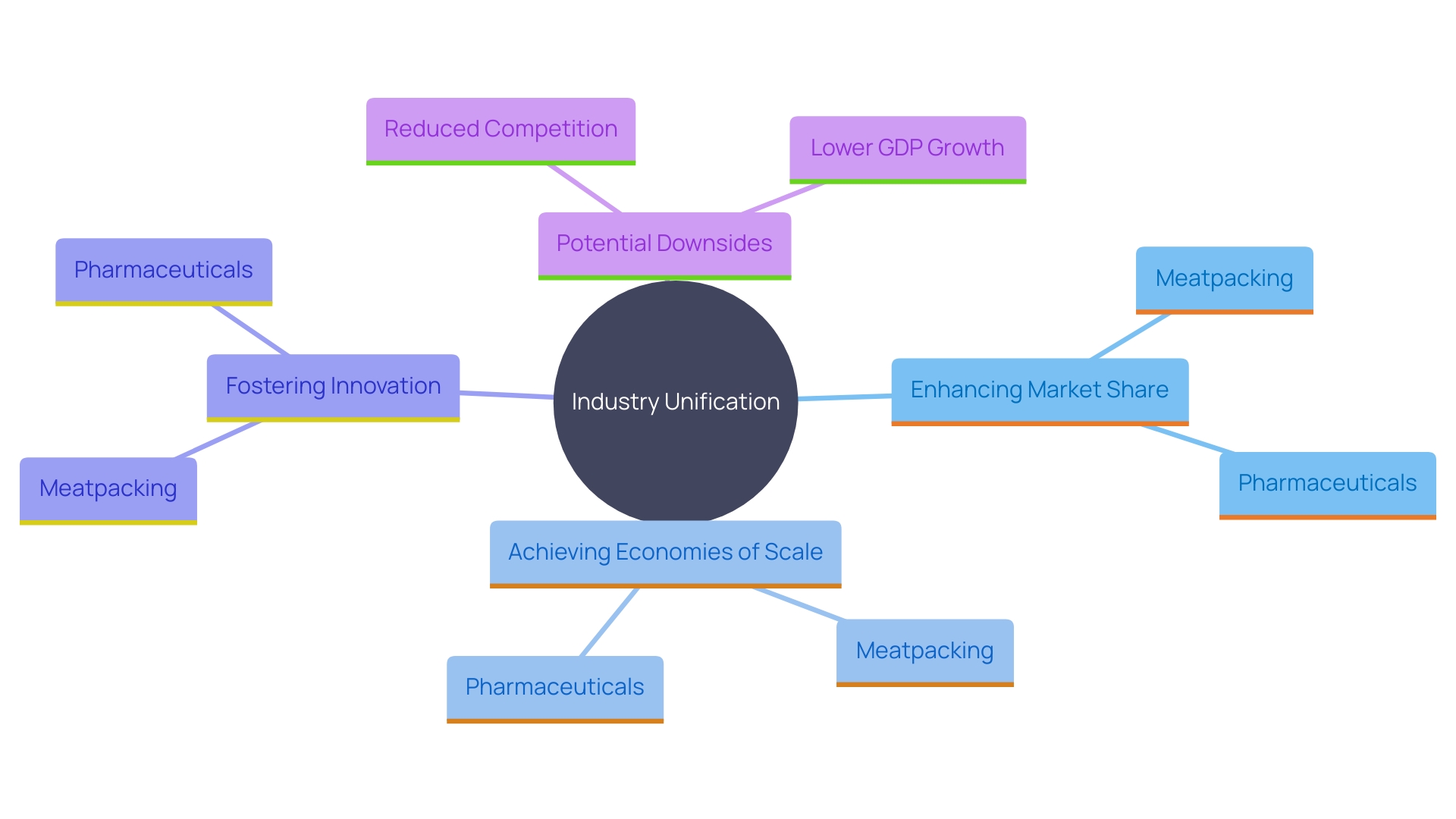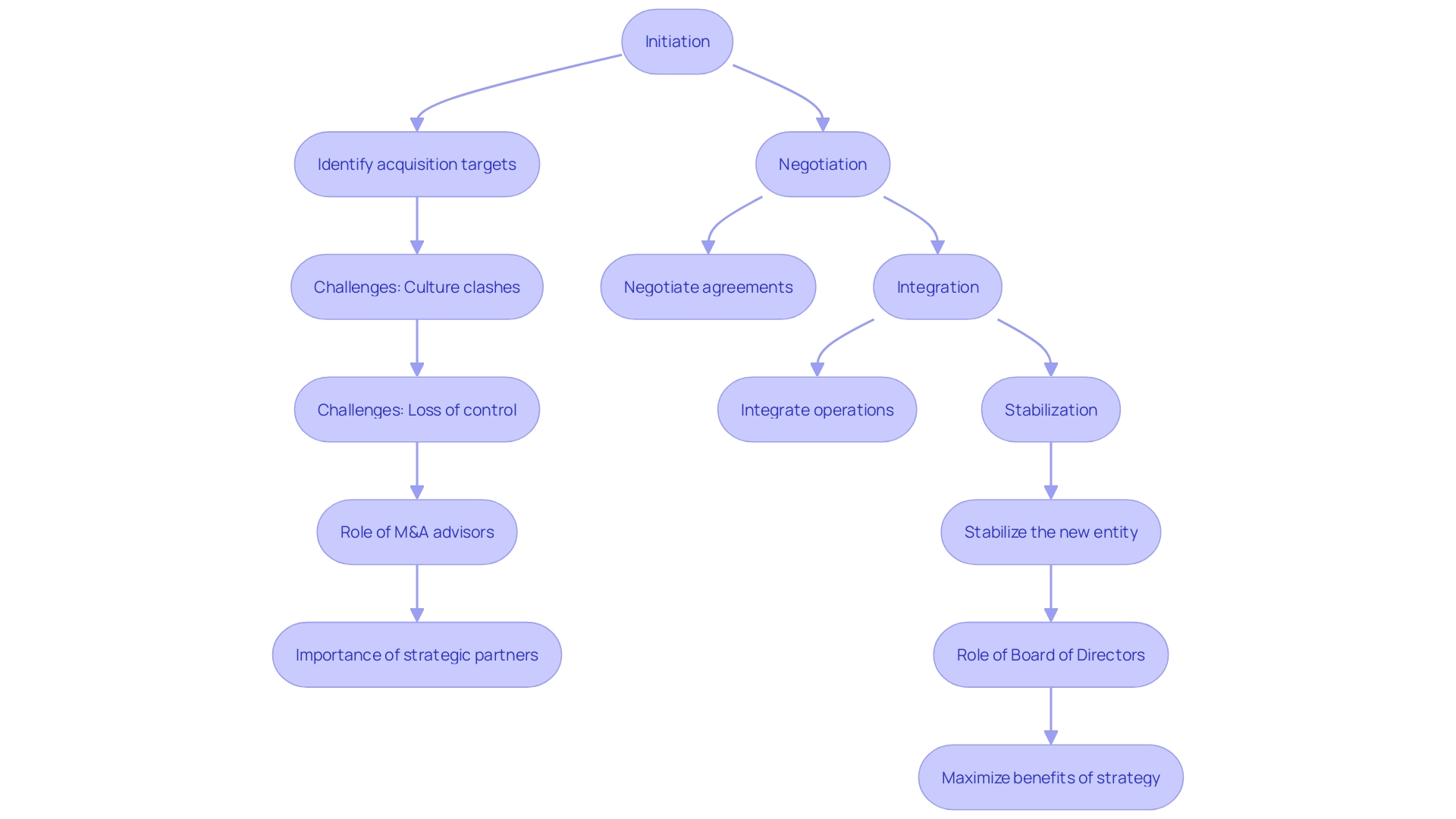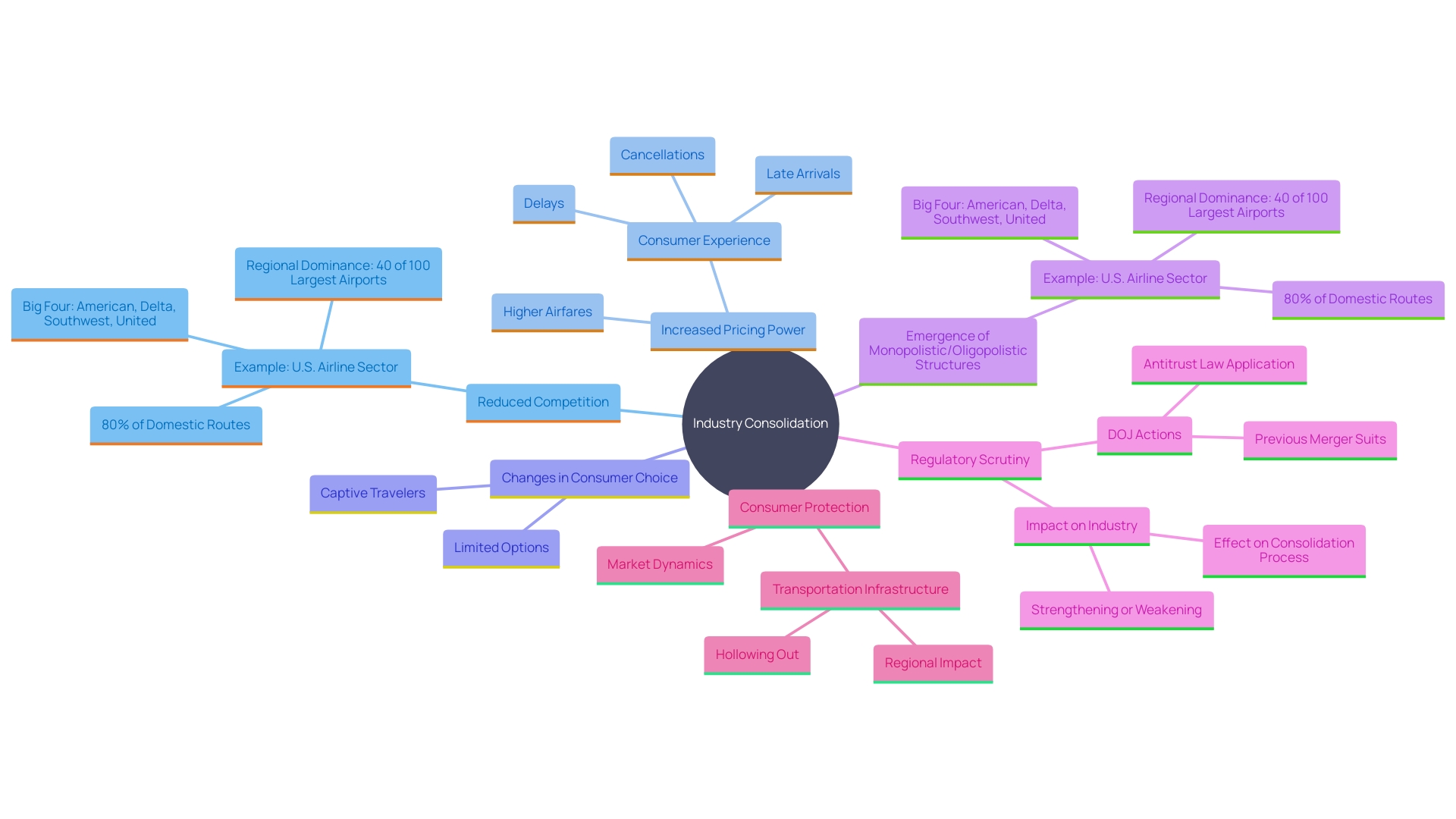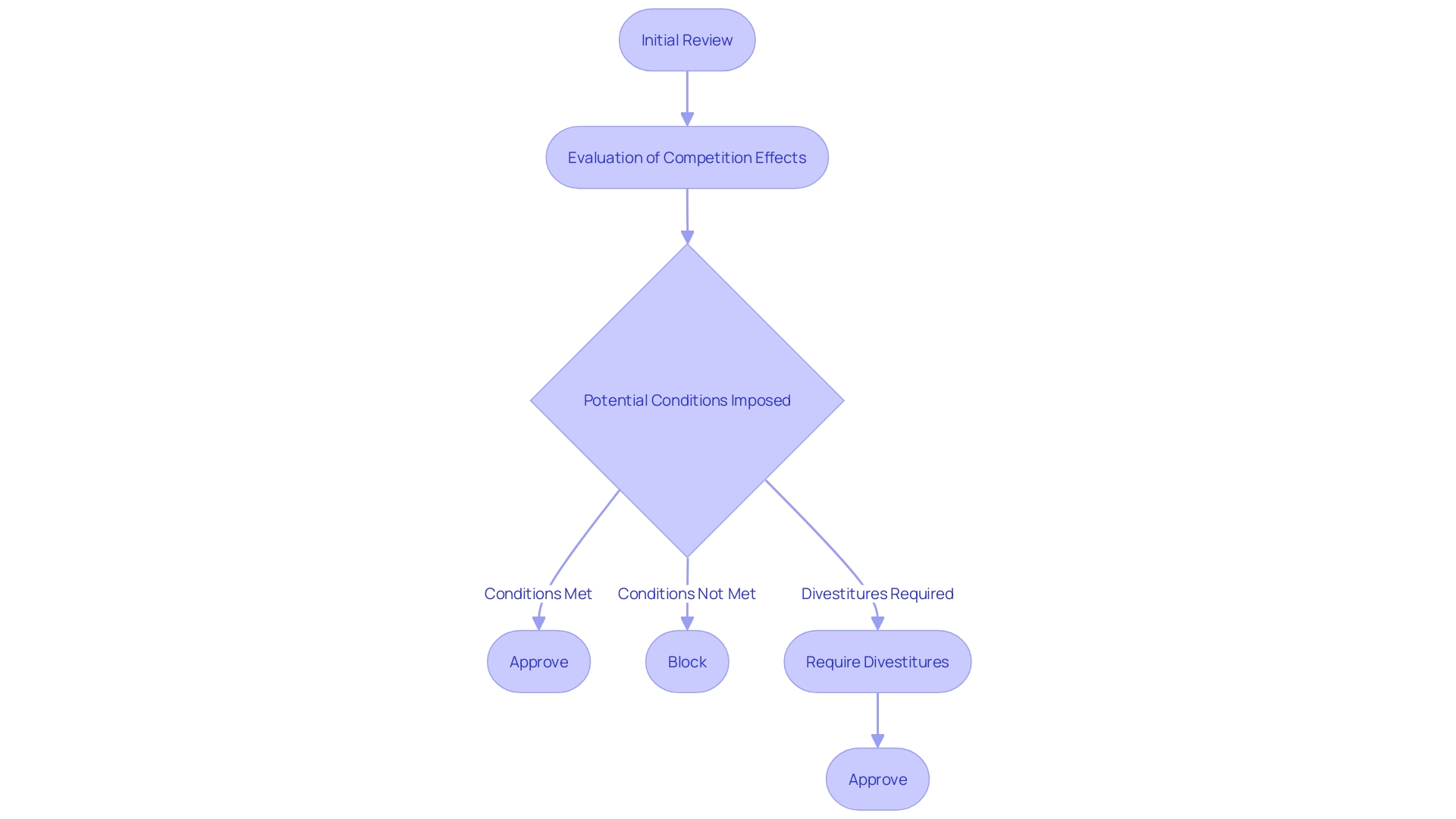Introduction
Industry consolidation is a complex and multifaceted phenomenon driven by strategic motives aimed at enhancing market share, achieving cost efficiencies, and strengthening competitive positioning. Companies pursue consolidation to capitalize on economies of scale and streamline operations, leading to significant improvements in profitability and market presence. This trend is evident across various sectors, including the meatpacking and pharmaceutical industries, where consolidation has reshaped market landscapes and fostered growth and innovation.
However, increased industry concentration also raises concerns about reduced competition, potential monopolistic behaviors, and broader economic implications. Understanding the stages of consolidation and the impact on market dynamics, alongside regulatory considerations, is crucial for stakeholders to navigate these changes effectively and develop strategies that balance growth with healthy competition.
Understanding the Motives for Consolidation
Industry unification is driven by multiple strategic motives that aim to enhance market share, cost efficiencies, and competitive positioning. Businesses frequently seek merging to capitalize on economies of scale and streamline operations, which can lead to significant improvements in profitability. For example, in the U.S. meatpacking sector, the merging of companies has allowed firms to achieve scale economies through larger facilities and improved collaboration with suppliers, ultimately reducing per-animal processing expenses.
Furthermore, consolidation enables companies to access new opportunities and broaden their customer base, encouraging growth and innovation. This was evident in the pharmaceutical sector, where mergers and acquisitions have reshaped the landscape, influencing innovation metrics such as patent filings and R&D expenditures while also affecting drug pricing strategies. These moves often result in a 'winner takes most' dynamic, raising barriers to entry and pushing leaders to leverage their scale for competitive advantage.
However, it is crucial to recognize the broader implications of increased sector concentration. While it can lead to enhanced efficiencies and growth, it may also decrease competition within the industry. Based on recent research, overall sector concentration has increased beyond historical standards, with the largest competitors acquiring more share and profits. This trend could lead to lower GDP growth due to decreased investment, less innovation, and reduced consumer choices.
Understanding these complex dynamics is essential for stakeholders to navigate the challenges of a consolidating industry effectively. By analyzing case studies and empirical information, stakeholders can better foresee the effects of merging on performance and create strategies to balance growth with competition.

Stages of Industry Consolidation
Industry consolidation unfolds through a structured series of stages: initiation, negotiation, integration, and stabilization. At first, companies recognize potential targets for acquisition or consolidation, considering strategic fit and market potential. For instance, the technology sector often employs a "soft" model of cooperation among competition agencies, facilitating information exchange through waiver letter procedures. This global approach originates from the 1990s when antitrust enforcement systems mandated international entities to submit consolidations for review, a practice now embraced by over 140 nations.
The negotiation phase involves detailed discussions to craft agreements, a process currently challenged by valuation gaps due to fluctuating interest rates. In 2023, M&A activity saw a significant drop, with strategic deals falling by an estimated 14%. Despite these challenges, some sectors, like life sciences, continue to engage in dynamic mergers and acquisitions, revealing trends and evolutionary patterns in the ecosystem.
Once an agreement is reached, the integration phase begins, aligning operations, cultures, and systems. This phase is critical for achieving anticipated benefits and often involves addressing cultural changes and management integration. Regular updates on integration progress, typically added to board meetings, help monitor this complex process.
Finally, stabilization occurs as the newly formed entity aims to solidify its position in the industry. This phase is essential for realizing the long-term benefits of merging, ensuring that strategic, operational, financial, and organizational goals are met. 'The resilience of leaders in various industries, such as Nvidia's recent rise, highlights the importance of effective consolidation in navigating disruptions and achieving sustained growth.'.

Impact of Consolidation on Market Dynamics
Consolidation significantly alters industry dynamics, often resulting in reduced competition, increased pricing power, and changes in consumer choice. As companies merge, the number of participants in the industry diminishes, potentially leading to monopolistic behaviors or oligopolies. This shift may elevate prices and reduce the diversity of products available to consumers. For instance, the U.S. airline sector has experienced significant unification over the past fifteen years, with mergers raising the share of the top four carriers from 56% to 80%. This concentration has diminished market responsiveness and increased dependency on taxpayer subsidies during crises.
Additionally, consolidation can prompt regulatory scrutiny as authorities seek to ensure fair competition and protect consumer interests. The recent decision to block the JetBlue-Spirit merger on antitrust grounds highlights the ongoing efforts to combat mergers that substantially reduce competition and harm consumer choice. Moreover, the Competition and Markets Authority's recent findings in the groceries sector reveal that high food price inflation has been driven largely by rising input costs, exacerbated by supply chain disruptions. Regulatory bodies continue to monitor and address these issues to maintain equilibrium and protect consumers from the negative impacts of reduced competition.

Regulatory Considerations and Interventions
Regulatory agencies play a crucial role in overseeing industry mergers to limit anti-competitive behaviors and maintain economic integrity. Merger and acquisition activities undergo rigorous review processes to evaluate their effects on competition, pricing, and consumer welfare. For instance, the European Commission expanded its authority in the Illumina-Grail case, demonstrating regulatory agencies' increasing vigilance. Agencies are empowered to impose conditions, mandate divestitures, or block deals altogether to ensure a balanced marketplace. This heightened scrutiny is evident in the Federal Trade Commission's unanimous decision to update the premerger notification rules under the Hart-Scott-Rodino Act, enhancing their ability to detect illegal mergers. Understanding these regulatory frameworks is crucial for companies considering consolidation as part of their growth strategy, especially in an era where stealth consolidation can lead to significant market dominance.

Conclusion
Industry consolidation presents both opportunities and challenges that require careful navigation by stakeholders. The strategic motives driving consolidation—such as enhancing market share, achieving cost efficiencies, and fostering innovation—are compelling. However, the implications of increased industry concentration cannot be overlooked.
While companies may benefit from economies of scale and improved profitability, the potential for reduced competition and monopolistic behaviors poses significant risks to market health and consumer choice.
The stages of consolidation—initiation, negotiation, integration, and stabilization—highlight the complexity of this process. Each phase demands strategic foresight and operational alignment to ensure that anticipated benefits are realized. As evidenced by ongoing M&A activity in certain sectors, understanding the dynamics of consolidation is essential for companies aiming to thrive in a rapidly evolving landscape.
Moreover, the impact of consolidation on market dynamics underscores the necessity for robust regulatory oversight. Regulatory bodies are increasingly vigilant in assessing mergers and acquisitions to mitigate anti-competitive practices and protect consumer welfare. Companies must remain aware of these regulatory considerations as they pursue growth strategies through consolidation.
By doing so, they can better position themselves to capitalize on the benefits while safeguarding against the potential downsides of a more concentrated market.




